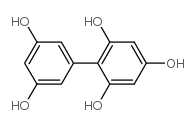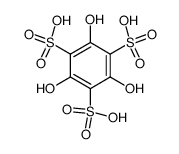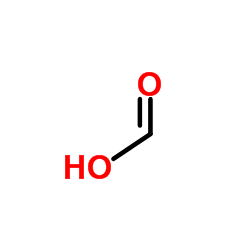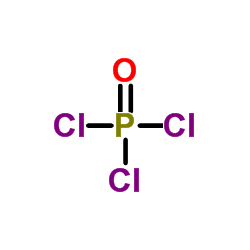Phloroglucide

Phloroglucide structure
|
Common Name | Phloroglucide | ||
|---|---|---|---|---|
| CAS Number | 491-45-2 | Molecular Weight | 234.20500 | |
| Density | 1.594g/cm3 | Boiling Point | 529.5ºC at 760 mmHg | |
| Molecular Formula | C12H10O5 | Melting Point | 216-218 ºC (water ) | |
| MSDS | N/A | Flash Point | 268.1ºC | |
Use of PhloroglucidePhloroglucide is a natural product that can be isolated from ferns[1]. |
| Name | Phloroglucide |
|---|---|
| Synonym | More Synonyms |
| Description | Phloroglucide is a natural product that can be isolated from ferns[1]. |
|---|---|
| Related Catalog | |
| References |
[1]. Harada, et al. Pharmaceutical Studies on Ferns. III. YAKUGAKU ZASSHI, 72(1), 153–154. |
| Density | 1.594g/cm3 |
|---|---|
| Boiling Point | 529.5ºC at 760 mmHg |
| Melting Point | 216-218 ºC (water ) |
| Molecular Formula | C12H10O5 |
| Molecular Weight | 234.20500 |
| Flash Point | 268.1ºC |
| Exact Mass | 234.05300 |
| PSA | 101.15000 |
| LogP | 1.88160 |
| Vapour Pressure | 7.91E-12mmHg at 25°C |
| Index of Refraction | 1.756 |
| Water Solubility | Slightly soluble (3.5 g/L) (25 ºC) |
Synonym:PHB Section 2 - COMPOSITION, INFORMATION ON INGREDIENTS
Risk Phrases: None Listed. Section 3 - HAZARDS IDENTIFICATION EMERGENCY OVERVIEW
The toxicological properties of this material have not been fully investigated.Hygroscopic (absorbs moisture from the air).Light sensitive. Potential Health Effects Eye: May cause eye irritation. Skin: May cause skin irritation. Ingestion: May cause irritation of the digestive tract. The toxicological properties of this substance have not been fully investigated. Inhalation: May cause respiratory tract irritation. The toxicological properties of this substance have not been fully investigated. Chronic: Not available. Section 4 - FIRST AID MEASURES Eyes: Flush eyes with plenty of water for at least 15 minutes, occasionally lifting the upper and lower eyelids. Get medical aid. Skin: Get medical aid if irritation develops or persists. Flush skin with plenty of soap and water. Ingestion: If victim is conscious and alert, give 2-4 cupfuls of milk or water. Never give anything by mouth to an unconscious person. Get medical aid. Inhalation: Remove from exposure and move to fresh air immediately. Get medical aid if cough or other symptoms appear. Notes to Physician: Section 5 - FIRE FIGHTING MEASURES General Information: As in any fire, wear a self-contained breathing apparatus in pressure-demand, MSHA/NIOSH (approved or equivalent), and full protective gear. Extinguishing Media: Use water spray, dry chemical, carbon dioxide, or chemical foam. Section 6 - ACCIDENTAL RELEASE MEASURES General Information: Use proper personal protective equipment as indicated in Section 8. Spills/Leaks: Sweep up or absorb material, then place into a suitable clean, dry, closed container for disposal. Avoid generating dusty conditions. Section 7 - HANDLING and STORAGE Handling: Wash thoroughly after handling. Use with adequate ventilation. Minimize dust generation and accumulation. Avoid contact with eyes, skin, and clothing. Keep container tightly closed. Avoid ingestion and inhalation. Storage: Store in a tightly closed container. Store in a cool, dry, well-ventilated area away from incompatible substances. Dark room. Section 8 - EXPOSURE CONTROLS, PERSONAL PROTECTION Engineering Controls: Use adequate ventilation to keep airborne concentrations low. Exposure Limits CAS# 491-45-2: Personal Protective Equipment Eyes: Wear appropriate protective eyeglasses or chemical safety goggles as described by OSHA's eye and face protection regulations in 29 CFR 1910.133 or European Standard EN166. Skin: Wear appropriate protective gloves to prevent skin exposure. Clothing: Wear appropriate protective clothing to prevent skin exposure. Respirators: Follow the OSHA respirator regulations found in 29 CFR 1910.134 or European Standard EN 149. Use a NIOSH/MSHA or European Standard EN 149 approved respirator if exposure limits are exceeded or if irritation or other symptoms are experienced. Section 9 - PHYSICAL AND CHEMICAL PROPERTIES Physical State: Solid Color: slightly brown Odor: Not available. pH: Not available. Vapor Pressure: Not available. Viscosity: Not available. Boiling Point: Not available. Freezing/Melting Point: 300 deg C Autoignition Temperature: Not available. Flash Point: Not available. Explosion Limits, lower: Not available. Explosion Limits, upper: Not available. Decomposition Temperature: Solubility in water: Specific Gravity/Density: Molecular Formula: C12H10O5 Molecular Weight: 234.21 Section 10 - STABILITY AND REACTIVITY Chemical Stability: Stable under normal temperatures and pressures. May discolor on exposure to light. Conditions to Avoid: Incompatible materials, light, exposure to moist air or water. Incompatibilities with Other Materials: Strong oxidizing agents. Hazardous Decomposition Products: Carbon monoxide, carbon dioxide. Hazardous Polymerization: Will not occur. Section 11 - TOXICOLOGICAL INFORMATION RTECS#: CAS# 491-45-2 unlisted. LD50/LC50: Not available. Carcinogenicity: Phloroglucide - Not listed by ACGIH, IARC, or NTP. Section 12 - ECOLOGICAL INFORMATION Section 13 - DISPOSAL CONSIDERATIONS Dispose of in a manner consistent with federal, state, and local regulations. Section 14 - TRANSPORT INFORMATION IATA Not regulated as a hazardous material. IMO Not regulated as a hazardous material. RID/ADR Not regulated as a hazardous material. Section 15 - REGULATORY INFORMATION European/International Regulations European Labeling in Accordance with EC Directives Hazard Symbols: Not available. Risk Phrases: Safety Phrases: S 24/25 Avoid contact with skin and eyes. WGK (Water Danger/Protection) CAS# 491-45-2: No information available. Canada None of the chemicals in this product are listed on the DSL/NDSL list. CAS# 491-45-2 is not listed on Canada's Ingredient Disclosure List. US FEDERAL TSCA CAS# 491-45-2 is not listed on the TSCA inventory. It is for research and development use only. SECTION 16 - ADDITIONAL INFORMATION N/A |
|
~75% 
Phloroglucide CAS#:491-45-2 |
| Literature: Briggs, Malcolm T.; Duncan, Graham L. S.; Thornber, Craig W. Journal of Chemical Research, Miniprint, 1982 , # 9 p. 2461 - 2487 |
|
~% 
Phloroglucide CAS#:491-45-2 |
| Literature: Pollak; Gebauer-Fuelnegg Monatshefte fuer Chemie, 1926 , vol. 47, p. 549 |
|
~% 
Phloroglucide CAS#:491-45-2 |
| Literature: Hlasiwetz Jahresbericht ueber die Fortschritte der Chemie und Verwandter Theile Anderer Wissenschaften, 1865 , p. 594 Journal fuer Praktische Chemie (Leipzig), 1866 , vol. <1> 97, p. 156 Full Text Show Details Herzig; Pollak Monatshefte fuer Chemie, 1894 , vol. 15, p. 701,703 |
|
~% 
Phloroglucide CAS#:491-45-2 |
| Literature: Hlasiwetz Jahresbericht ueber die Fortschritte der Chemie und Verwandter Theile Anderer Wissenschaften, 1865 , p. 594 Journal fuer Praktische Chemie (Leipzig), 1866 , vol. <1> 97, p. 156 Full Text Show Details Herzig; Pollak Monatshefte fuer Chemie, 1894 , vol. 15, p. 701,703 |
|
~% 
Phloroglucide CAS#:491-45-2 |
| Literature: Cross; Bevan Journal of the Chemical Society, 1911 , vol. 99, p. 1455 |
|
~% 
Phloroglucide CAS#:491-45-2 |
| Literature: Schiff,H. Justus Liebigs Annalen der Chemie, 1874 , vol. 172, p. 358 |
|
~% 
Phloroglucide CAS#:491-45-2 |
| Literature: Pollak; Gebauer-Fuelnegg Monatshefte fuer Chemie, 1926 , vol. 47, p. 549 |
| HS Code | 2906299090 |
|---|---|
| Summary | 2906299090 other aromatic alcohols。Supervision conditions:None。VAT:17.0%。Tax rebate rate:9.0%。MFN tariff:5.5%。General tariff:30.0% |
| 2-(3,5-dihydroxyphenyl)benzene-1,3,5-triol |
| Biphenyl-2,3',4,5',6-pentaol |
| Phloroglucide |
| Phloroglucide hydrate |
| MFCD00044547 |
| 2,4,6,3',5'-Biphenylpentol |
| Phloroglucinol Impurity 4 |





